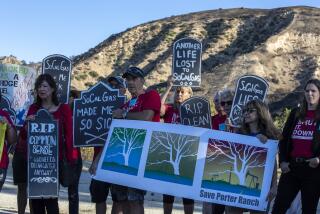Fill ‘er Up
- Share via
If the public has a beef with the vapor-recovery equipment on most of California’s gasoline hoses, it is because the gadgets are unwieldy for the majority who pump their own gas. Society has already decided that is an acceptable price to pay for cleaner and safer air, and the latest equipment is lighter. But that doesn’t mean service station dealers have to like it.
Among their complaints, in addition to the $5,000-per-station cost and malfunctions in the hands of amateurs, is the slow rate of gasoline flow. The California Air Resources Board originally limited the rate to eight gallons per minute, compared to a rate of perhaps 13 gallons per minute on conventional gasoline hoses. The faster the flow, the CARB says, the more likely it is that gasoline will spill out when the flow is stopped.
Dean Simeroth, an engineering chief at the CARB, said the allowable rate has since been raised to 10 gallons a minute. However, the typical flow in actual day-to-day usage is probably six to eight gallons a minute. He says that is only about two gallons a minute slower than the real-life flow from uncontrolled hoses. Service station dealers retort that the gap is closer to five gallons a minute.
Does this matter? It does to dealers because the longer it takes, the less gasoline can be pumped in a day. This is just a blip on the screen, however, because other factors have at least doubled the daily volume pumped by each station since the early 1970s. As for motorists, a five-gallon-per-minute penalty means 94 seconds instead of 51 seconds to fill an 11-gallon tank. In the case of gasoline lines during a shortage, it won’t help. But it probably won’t be the biggest problem in town.
The equipment captures gasoline vapors from the nozzles and vehicle fuel tanks that would otherwise send hydrocarbons into the air. Hydrocarbons are one of two ingredients that lead to the formation of smog in the presence of sunlight. The vapors also expose motorist to the toxin benzene, the CARB says. About 90% of the gasoline pumped in the state passes through vapor recovery equipment, a level that is now mandated to rise to 100%.
Everything else might be growing by leaps and bounds in Southern California, but not the number of service stations. According to a recent census by the Lundberg Survey, the national gasoline market research firm based in North Hollywood, there are 5,252 gasoline stations in the Los Angeles area--a whopping 41% decline from the 8,961 that existed in 1974.
Over the same period, the number of cars and trucks has leaped by 39% to 9.55 million from 6.87 million, Lundberg reports. The census spanned Los Angeles, Orange, Riverside, San Bernardino and Ventura counties. That adds up to a station for every 1,818 cars, compared to one for every 767 cars a decade and a half ago.
It doesn’t take an auto mechanic to recognize that something is being turned on its head, and it’s the nature of the stations. They are bigger, more varied and open more hours. In 1974, the average Los Angeles station had 7.3 gasoline nozzles and no hot dogs. Today, Lundberg says, it has 11.7 nozzles and is much more likely to sell food.
Lundberg’s people counted nearly 62,000 nozzles in the five-county area, a modest decline of about 6% from the 65,415 nozzles that brightened the landscape a decade and a half ago. But the logistics have worsened significantly because of the explosion in the number of gasoline tanks during the same period. Today, there is a nozzle for every 155 cars, compared to one for every 105 cars previously.
Another big difference: more than 12,000 service bays have been lost since 1974. Today’s average station has less than two service bays, compared to almost three back then. That business has gone to tire, muffler, quick-lube and other specialty shops.
Service station owners, whose colleagues were shot, stabbed and otherwise abused during the previous gasoline lines in Southern California, are offering a $1,000 reward for the best idea to avoid or minimize gasoline lines the next time. To win, the idea would have to be incorporated into government contingency plans, says Stephen R. Shelton, who is making the offer on behalf of the Southern California Service Station Assn. in Irvine.
“It’s that important to our people,” Shelton says. “I’m just trying to find a plan to deal with queues more intelligently than we have in the past.”
The people whose job it is to plan for the next energy crisis, the California Energy Commission, are preparing a new contingency plan to replace the one adopted in 1983. The issue of gasoline lines hasn’t yet been reviewed, officials said.
Shelton says he has his own ideas, and assures would-be entrants that he wouldn’t accept his own prize. He argues that the key to minimizing lines is spreading motorists’ station visits across 24 hours, which could be done by requiring each driver to buy gas at the hour corresponding to the last digit in the car’s license plate.
“It would be more like an appointment,” he says.
The rest of his plan has half of all stations staying open for the first half of the day, the other half opening the rest of the day. Each motorist would have to make a minimum dollar purchase, and would pay it even if his gas tank wouldn’t take that much fuel.
More to Read
Inside the business of entertainment
The Wide Shot brings you news, analysis and insights on everything from streaming wars to production — and what it all means for the future.
You may occasionally receive promotional content from the Los Angeles Times.










